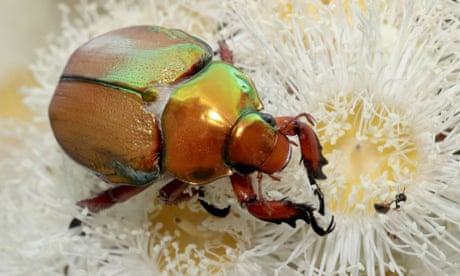- by foxnews
- 31 Jan 2025
‘A huge worry’: Christmas beetle decline spurs calls for citizen sightings
‘A huge worry’: Christmas beetle decline spurs calls for citizen sightings
- by theguardian
- 19 Dec 2022
- in news

Christmas beetles were once harbingers of the festive season, appearing en masse in the Australian summer months. In November 1936 a regional Queensland paper reported that after heavy rain, the beetles "swarmed in clouds, and walls were covered with the insects, while the noise of their whirring wings in confined spaces between buildings was like the sound of a far-off aeroplane".
Many Australians have summer memories of the beetles: their colourful, shimmery exoskeletons and their clumsy way of flying - sometimes into people's mouths and ears.
"That's a huge worry. If Christmas beetles have declined and we've noticed, how many things have declined and we haven't noticed?"
Spurred by a lack of long-term data, Latty and her colleagues are calling on volunteers to contribute to their monitoring of Christmas beetle populations.
In collaboration with Invertebrates Australia, the researchers are encouraging members of the public to snap pictures of the beetles and upload the images to the iNaturalist app or website.
Christmas beetles are scarabs in the genus Anoplognathus, with 35 known species in Australia.
Generally, Latty says, the insects have iridescent exoskeletons, which appear to change colour when viewed from different angles. The beetles also have what resembles a duck's bill towards the front of the "face" region, and thickened rear legs that look "like they're wearing 80s-style leg warmers". But none of these characteristics on their own is a definitive identifier, Latty adds.
Christmas beetle larvae live in soil and feed on the roots of native grasses. "We think habitat loss may be one of the drivers of the decline," Latty says. "If you get rid of those open woodlands that have that nice native grass understory, you don't have habitat for the larvae and then you don't have adults coming out."
The seeming disappearance of the Christmas beetle is emblematic of a larger problem. For years entomologists have been reporting startling declines in insect populations worldwide.
In her seminal 1962 environmental book The Silent Spring, Rachel Carson wrote: "Without insect pollination most of the soil-holding and soil-enriching plants of uncultivated areas would die out, with far-reaching consequences to the ecology of [a] whole region."
Many species depend on invertebrates for food. "A world without insects," Carson also noted, would be "a sterile world ungraced by the curving wing of a bird in flight".
Latty adds that insects are also "important for pest control, for waste management, for soil health".
Insect declines have resulted from a combination of habitat destruction and degradation and pesticide use. They are also particularly vulnerable to the effects of climate change, Laurance says, because "they're just so small and susceptible to external vicissitudes".
A lack of long-term data has meant that scientists have often had to piece together population changes after the fact, in a process of "forensic ecology", according to Laurance.
A paper he co-authored, published in November, warned that "if no action is taken to better understand and reduce the action of climate change on insects, we will drastically reduce our ability to build a sustainable future based on healthy, functional ecosystems".
Because insects reproduce rapidly - Christmas beetles have a life cycle of about one year from egg to adult - "often if you know that there's a problem and you take steps to mitigate that problem, they can recover pretty quickly," Latty says.
- by foxnews
- descember 09, 2016
Flight passenger asks who controls entertainment center for extra seat, ignites etiquette debate
A flight passenger asked on Reddit about the use of the entertainment center when sitting in a two-seat, exit-row chair, with folks on social media weighing in. An etiquette expert shared insights.
read more


